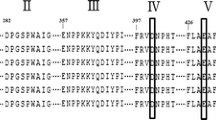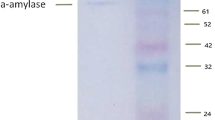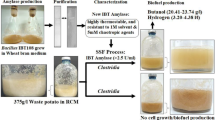Abstract
This study reports the purification and biochemical characterization of a novel maltotetraose-forming-α-amylase from Pseudomonas stutzeri AS22, designated PSA. The P. stutzeri α-amylase (PSA) was purified from the culture supernatant to homogeneity by Sepharose mono Q anion exchange chromatography, ultrafiltration and Sephadex G-100 gel filtration, with a 37.32-fold increase in specific activity, and 31% recovery. PSA showed a molecular weight of approximately 57 kDa by SDS-PAGE. The N-terminal amino acid sequence of the first 7 amino acids was DQAGKSP. This enzyme exhibited maximum activity at pH 8.0 and 55°C, performed stably over a broad range of pH 5.0 ≈ 12.0, but rapidly lost activity above 50°C. Both potato starch and Ca2+ ions have a protective effect on the thermal stability of PSA. The enzyme activity was inhibited by Hg2+, Mn2+, Cd2+, Cu2+, and Co2+, and enhanced by Ba2+. PSA belonged to the EDTA-sensitive α-amylase. The purified enzyme showed high stability towards surfactants (Tween 20, Tween 80 and Triton X-100), and oxidizing agents, such as sodium per borate and H2O2. In addition, PSA showed excellent compatibility with a wide range of commercial solid and liquid detergents at 30°C, suggesting potential application in the detergent industry. Maltotetraose was the specific end product obtained after hydrolysis of starch by the enzyme for an extended period of time, and was not further degraded.
Similar content being viewed by others
References
Owino, V. O, L. M. Kasonka, M. M. Sinkala, J. K. Wells, S. Eaton, T. Darch, A. Coward, A. M. Tomkins, and S. M. Filteau (2007) Fortified complementary foods with or without alpha amylase treatment increase hemoglobin but do not reduce breast milk intake of 9-mo-old Zambian infants. Am. J. Clin. Nutr. 86: 1094–1103.
Van der Maarel, M. J. E. C., B. Van der Veen, J. C. M. Uitdehaag, H. Leemhuis, and L. Dijkhuizen (2002) Properties and applications of starch converting enzymes of the α-amylase family. J. Biotechnol. 94: 137–155.
Sivaramakrishnan, S., D. Gangadharan, K. M. Nampoothiri, C. R. Soccol, and A. Pandey (2006) α-Amylases from microbial sources-An overview on recent developments. Food Technol. Biotechnol. 44: 173–184.
Aiyer, P. V. (2005) Amylases and their applications. Afri. J. Biotechnol. 4: 1525–1529.
Gupta, R., P. Gigras, H. Mohapatra, V. K. Goswami, and B. Chauhan (2003) Microbial α-amylase: A biotechnological perspective. Proc. Biochem. 38: 1599–1616.
Pandey, A., P. Nigam, C. R. Soccol, T. V. Soccol, D. Singh, and R. Mohan (2000) Advances in microbial amylases. Biotech. Appl. Biochem. 31: 135–152.
Malabendu, J., M. Chiranjit, S. Saptadip, R. P. Bikas, I. S. Syed, K. D. M. Pradeep, and C. M. Keshab (2013) Salt-independent thermophilic α-amylase from Bacillus megaterium VUMB109: An efficacy testing for preparation of maltooligosaccharides. Ind. Crops. Prod. 41: 386–391.
Soleimani, M., A. Khani, and K. Najafzadeh (2012) α-Amylase immobilization on the silica nanoparticles for cleaning performance towards starch soils in laundry detergents. J. Mol. Catal. B: Enzym. 74: 1–5.
Gangadharan, D., K. M. Nampoothiri, S. Sivaramakrishnan, and A. Pandey (2009) Immobilized bacterial α-amylase for effective hydrolysis of raw and soluble starch. Food Res. Int. 42: 436–442.
Robyt, J. F. and R. J. Ackerman (1971) Isolation, purification and characterization of a maltotetraose-producing amylase from Pseudomonas stuzeri. Arch. Biochem. Biophys. 145: 105–114.
Nakada, T., M. Kubota, S. Sakai, and Y. Tsujisaka (1990) Purification and characterization of two forms of maltotetraose-forming amylase from Pseudomonas stutzeri. Agric. Biol. Chem. 54: 737–743.
Sakano, Y., Y. Kashiwagi, and T. Kobayashi (1982) Purification and properties of an exo-α-amylase from Pseudomonas stutzeri. Agric. Biol. Chem. 46: 639–646.
Sakano, Y., Y. Kashiwagi, and T. Kobayashi (1983) Purification of a maltotetraose-forming exo-amylase of Pseudomonas stutzeri: Two-forms of the amylase and their enzymatic properties. Agric. Biol. Chem. 47: 1761–1768.
Fujita, M., K. Torigoe, T. Nakada, K. Tsusaki, M. Kubota, S. Sakai, and Y. Tsujisaka (1989) Cloning and nucleotide sequence of the gene (amyP) for maltotetraose-forming amylase from Pseudomonas stutzeri MO-19. J. bacteriol. 171: 1333–1339.
Zhang, J. and R. Zeng (2011) Molecular cloning and expression of an extracellular α-amylase gene from an Antarctic deep sea psychrotolerant Pseudomonas stutzeri strain 7193. World J. Microb. Biot. 27: 841–850.
Fogarty, W. M., C. T. Kelly, A. C. Bourke, and E. M. Doyle (1994) Extracellular maltotetraose-forming amylase of Pseudomonas sp. IMD 353. Biotechnol. 16: 473–478.
Zhou, J., T. Baba, T. Takano, S. Kobayashi, and Y. Arai (1989) Nucleotide sequence of the maltotetraohydrolase gene from Pseudomonas saccharophila. FEBS. Lett. 255: 37–41.
Kimura, T. and K. Horikoshi (1989) Production of amylase and pullulanase by an alkalopsychrotrophic Micrococcus sp. Agric. Biol. Chem. 53: 2963–2968.
Takasaki, Y. (1983) An amylase producing maltotetraose and maltopentaose from Bacillus circulans. Agric. Biol. Chem. 47: 2193–2199.
Kim, T. U., B. G. Gu, J. Y. Jeong, S. M. Byun, and Y. C. Shin (1995) Purification and characterization of a maltotetraose-forming alkaline α-amylase from an alkalophilic Bacillus strain GM8901. Appl. Environ. Microbiol. 61: 3105–3112.
Murakami, S., K. Nagasaki, H. Nishimoto, R. Shigematu, J. Umesaki, S. Takenaka, J. Kaulpiboon, M. Prousoontorn, T. Limpaseni, P. Pongsawasdi, and K. Aoki (2008) Purification and characterization of five alkaline, thermotolerant, and maltotetraose-producing α-amylases from Bacillus halodurans MS-2-5, and production of recombinant enzymes in Escherichia coli. Enz. Microbiol. Technol. 43: 321–328.
Sneath, P. H. A., N. S. Mair, M. E. Sharpe, and J. G. Holt (1986) Bergey’s Manual of Systematic Bacteriology. 9th ed., pp. 1063–1065. Williams and Wilkins, Baltimore.
Miller, J. H. (1972) Experiments in Molecular Genetics. pp. 431–435. Cold spring Harbor Laboratory, Cold Spring Harbor, NY, USA.
Miller, G. L. (1959) Use of dinitrosalycilic acid reagent for determination of reducing sugars. Anal. Chem. 31: 426–428.
Laemmli, U. K. (1970) Cleavage of structural proteins during the assembly of the head of bacteriophage T4. Nature 227: 680–685.
Bradford, M. (1976) A rapid and sensitive method for the quantification of microgram quantities of protein utilizing the principle of protein dye binding. Anal. Biochem. 72: 248–254.
Kobayashi, H., Y. Takaki, H. Takami, and A. Inoue (2000) Characterization of α-maltotetraohydrolase produced by Pseudomonas sp. MS300 isolated from the deepest site of Mariana trench. Deep Sea Res. 16: 109–116.
Janeek, Š. and B. Štefan (1992) α-Amylases and approaches leading to their enhanced stability. FEBS Lett. 304: 1–3.
Suvd, D., Z. Fujimoto, K. Takase, M. Matsumura, and H. Mizuno (2001) Crystal structure of Bacillus Stearothermophilus α-amylase: Possible factors determining the thermostability. J. Biochem. 129: 461–468.
Sajedi, R. H., H. Naderi-Mahesh, K. Khajeh, R. Ahmadvand, B. A. Ranjbar, A. Asoodeh, and F. Moradian (2005) A calcium independent α-amylase that is active and stable at low pH from the Bacillus sp. KR-8104. Enz. Microb. Technol. 36: 666–671.
Mehta, M. and T. Satyanarayana (2013) Biochemical and molecular characterization of recombinant acidic and thermostable raw-starch hydrolyzing α-amylase from an extreme thermophile Geobacillus thermoleovorans. J. Mol. Catal. B: Enzym. 85: 229–238.
Kikani, B. A. and S. P. Singh (2012) The stability and thermodynamic parameters of a very thermostable and calcium-independent α-amylase from a newly isolated bacterium, Anoxybacillus beppuensis TSSC-1. Proc. Biochem. 47: 1791–1798.
Vallee, B. L., E. A. Stein, W. N. Sumerwell, and E. H. Fischer (1959) Metal content of α-amylases of various origins. J. Biol. Chem. 234: 2901–2905.
Volkin, D. B. and A. M. Klibanov (1989) Thermal destruction processes in proteins involving cysteine. J. Biol. Chem. 89: 2945–2950.
Tanaka, A. and E. Hoshino (2003) Secondary calcium-binding parameter of Bacillus amyloliquefaciens α-amylase obtained from inhibition kinetics. J. Biosci. Bioeng. 96: 262–267.
Morishita, Y., K. Hasegawa, Y. Matsuura, Y. Katsube, M. Kubota, and S. Sakai (1997) Crystal structure of a maltotetraoseforming exo-amylase from Pseudomonas stutzeri. J. Mol. Biol. 267: 661–672.
Heinen, W. and A. M. Lauwers (1976) Amylase activity and stability at high and low temperature depending on calcium and other divalent cations. Experientia Suppl. 26: 77–89.
Michelin, M., T. M. Silva, V. M. Benassi, S. C. P. Nogueira, L. A. B. Moraes, J. M. Leão, J. A. Jorge, H. F. Terenzi, and M. L. T. M. Polizeli (2010) Purification and characterization of a thermostable α-amylase produced by the fungus Paecilomyces variotii. Carbohydr. Res. 345: 2348–2353.
Hagihara, H., K. Igarashi, Y. Hayashi, K. Endo, K. Ikawa, K. Ozaki, S. Kawai, and S. Ito (2001) Novel α-amylase that is highly resistant to chelating reagents and chemical oxidants from the alkaliphilic Bacillus isolate KSM-K38. Appl. Environ. Microbiol. 67: 1744–1750.
Hatada, Y., N. Masuda, M. Akita, M. Miyazaki, Y. Ohta, and K. Horikoshi (2006) Oxidatively stable maltopentaose-producing α-amylase from a deep-sea Bacillus isolate, and mechanism of its oxidative stability validated by site-directed mutagenesis. Enz. Microb. Technol. 39: 1333–1340.
Author information
Authors and Affiliations
Corresponding author
Rights and permissions
About this article
Cite this article
Maalej, H., Hmidet, N., Ghorbel-Bellaaj, O. et al. Purification and biochemical characterization of a detergent stable α-amylase from Pseudomonas stutzeri AS22. Biotechnol Bioproc E 18, 878–887 (2013). https://doi.org/10.1007/s12257-012-0862-z
Received:
Revised:
Accepted:
Published:
Issue Date:
DOI: https://doi.org/10.1007/s12257-012-0862-z




